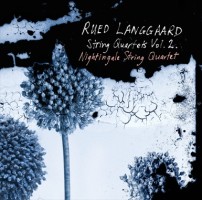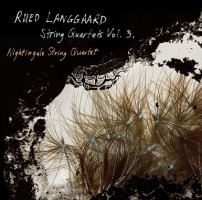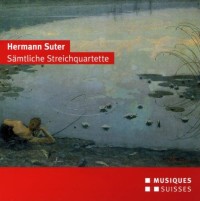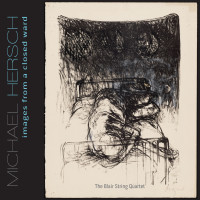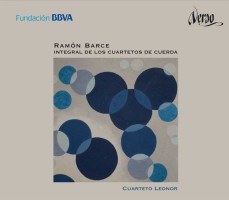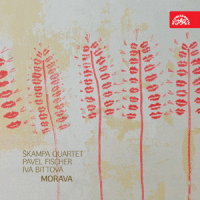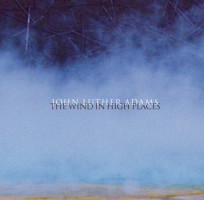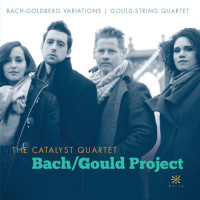String Theory 14: 28 Quartets, etc.
|
Grant Chu Covell [November 2015.]
“String Quartets Vol. 2.” Rued LANGGAARD: Rosengaardsspil (“Rose Garden Play”) (1918); String Quartet in A-flat (1918); String Quartet No. 4, “Sommerdage” (“Summer Days”) (1914-18; rev. 1931). Nightingale String Quartet: Gunvor Sihm, Josefine Dalsgaard (vln), Marie Louise Broholt Jensen (vla), Louisa Schwab (vlc). Dacapo 6.220576 (1 SACD) (http://www.dacapo-records.dk/). “String Quartets Vol. 3.” Rued LANGGAARD: String Quartet No. 1 (1914-15; rev. 1936); String Quartet No. 5 (1925; rev. 1926-38); Italian Scherzo (1950). Nightingale String Quartet: Gunvor Sihm, Josefine Dalsgaard (vln), Marie Louise Broholt Jensen (vla), Louisa Schwab (vlc). Dacapo 6.220577 (1 SACD) (http://www.dacapo-records.dk/). Volume 2 continues the Nightingales’ luminescent Langgaard survey with three quartets sparked by an unrequited youthful romance during a summer in Sweden. What happened among the roses remains a mystery, as the unrestrained revisionist Langgaard has proven to be an unreliable historian. Chronology means little where Langgaard is concerned. Exceptionally anachronistic, there are maneuverings that suggest a close study of Beethoven. Langgaard could also be as bright as Rossini or Mendelssohn. There are also dark moments and extended passages without musical development that wouldn’t become commonplace until 20th-century minimalism and post-Romanticism. But Langgaard had no sense of irony. Adopting older styles and mixing them up never bothered him, although it would have alienated and confused audiences. The 1918 quartet titled Rosengaardsspil arranges Classical and Romantic gestures like appliques on faded wallpaper. A scherzo titled “Mozart” is actually not Classical but more like Mendelssohn’s youthful string symphonies. The finale, Rococo, anchors in a later age. The other 1918 quartet, in A-flat, has ghosts of Beethoven’s Op. 130 running through its precise movements. No. 4 rummages through Rosegaardsspil; however, this time through it’s gushingly late Romantic. Slow movements in these three tend to be sad. Volume 3 offers two larger quartets, No. 1 and No. 5. Both are darker, with more heightened Romantic harmonies, but lacking in extensive developments despite sincere attempts. The First’s brooding slow movement unleashes an astonishing tantrum. The Finale, Sostenuto, reflects Langgaard’s antiquated Romantic style. No. 5 has a later genesis, and was reworked after Langgaard’s anachronistic stylistic shift. A more mature quartet, its expressive Romanticism can darken abruptly, and its dissonance begrudgingly resolves. This is eccentric music, beautiful in parts, but not as extensively developed as might be expected from the maturity of the exposition. Langgaard dashed off the Italian Scherzo in 30 minutes on the morning of October 21, 1950. It’s a two-minute limpid statement, impetuous and capricious, but the harmony no longer aligns with Classical forms. The Nightingales are perfect.
Hermann SUTER: String Quartet No. 1, Op. 1 (1901); String Quartet No. 2, Op. 10 (1910); String Quartet No. 3, Op. 20, “Amselrufe” (1918). BeethovenQuartett: Mátyás Bartha, Laurentius Bonitz (vln), Vahagn Aristakesyan (vla), Carlos Conrad (vlc). Musiques Suisses MGB CD 6279 (1 CD) (http://www.musiques-suisses.ch/). In Hermann Suter (1870-1926) we find a craftsman thoroughly schooled in tradition developing at a modest pace. The First reveals connections with Brahms and Schumann, however there are late-Romantic harmonic and rhythmic twists in the brief scherzo, Moderato, con svogliatezza, that would surprise even Mahler and Strauss. The Second, in C-sharp minor, has Beethoven’s Op. 111 as a model. In two movements, like the sonata, the concluding movement is a theme and variations balancing a tonal theme against unsteady, unresolved and unprepared dissonance. It would stand well on a program with Sibelius’ nearly contemporaneous Voces Intimae. The Third steps sideways and back, like rosy late Strauss. The First World War had recently concluded and Suter was contemplating a more ideal time; “the blackbird’s call” expresses nostalgia and the desire to return to stability and simplicity. No. 3 can get dark, but Suter will pivot back to bright, innocent light. These are three different quartets demanding different modes of expression and playing styles; the BeethovenQuartett has made a dedicated study. They are all recorded on different dates, but within the same two-month period. No. 1 has more atmosphere which suits the most Romantic of the three.
Michael HERSCH: Images From a Closed Ward (2010). The Blair String Quartet: Christian Teal, Cornelia Heard (vln), John Kochanowski (vla), Felix Wang (vlc). Innova 884 (1 CD) (http://www.innova.mu/). Reflecting Michael Mazur’s eponymous etchings, Hersch’s despairing quartet grinds and thrashes through 13 bitter movements. Born from slow dissonant chords like constricted breathing (I), clusters and tightly spun lines express agony. Most of the time, the quartet labors together, chords and intervals chosen for maximum dissonance. There’s nothing to come back to and hum. The overall experience is suffocating and miserable. The 42-minute arc culminates in XI, the longest and angriest of the series. The slow lashing has passed through irregular forceful chords (II, IV), stark struck chords (VIII) to arrive at the heated barrage (XI), before receding completely spent and resentful. Mazur’s art proliferates on the cover and booklet. This is not the sort of music a string quartet choses at random. With experience and confidence, the Blair is able to navigate this grim, yet expressive work.
Ramón BARCE: Cuarteto I (1958); Cuarteto II (1965); Cuarteto III, “Cuarteto Gauss” (1973); Cuarteto IV (1975); Cuarteto V (1978); Cuarteto VI (1978); Cuarteto VII, “de la Salud” (1978); Cuarteto VIII (1983); Cuarteto IX (1994); Cuarteto X (1994); Cuarteto XI, “Pieza para Cuarteto” (1999). Cuarteto Leonor: Delphine Caserta, Enrique Rivas (vln), Jaime Huertas (vla), Álvaro Huertas (vlc). Verso VRS 210 (3 CDs) (http://www.verso.es/). Cuarteto Leonor has achieved a monumental task with these three discs (64:07 + 44:21 + 63:09). Barce’s quartets disclose an intensely cultivated path. All 11 are succinct. No. 1 reflects dominant 21st-century trends with modernist expression. No. 2’s two movements show Barce heading down the road towards abstraction, and by No. 3 the Spanish composer has arrived at a distinctive style. Phrases have given way to angular repeating and intersecting gestures, handled like mobiles. Barce does not wander and does not give in to excess. There is little audible development, except for gradual mutation through repetition and recombination. Rhythms usually align to a grid; consistent atonality is highly valued. Martinů also enjoyed similar motor rhythms, but he always brought his harmonies into the sunshine now and again. Nos. 5, 6 and 7 all date from 1978. Nothing is representational; there are no folk tunes, allusions to other music. If picking favorites, No. 8 is particularly engaging. It’s narrowly the longest (21:11) whereas most Barce quartets hug the quarter-hour mark. This 1983 work has pronounced tempo fluctuations. It’s as if he reviewed Schoenberg’s last two and took notes on the things he liked. Like No. 3, the Ninth is a single movement (No. 11 is a single movement too, but at 5:36 it’s more like a fragment), and returns to the fragmented mobiles of earlier quartets. Irregularly repeated pitches, like Morse code, recur to bind the discourse. The Tenth is the second longest (20:51), and like No. 8, the slight increase in expression results in lengthier forms. The brief but characteristically restless No. 11 was part of a European Broadcasting Union project, “One Thousand Years of Polyphony,” commemorating Pérotin’s Viderunt Omnes.
Pavel FISCHER: String Quartet No. 1, “Morava” (2008)1; String Quartet No. 2, “Wild Mountain Thyme” (2009)2; String Quartet No. 3 (2011)3; Jedú chlapci, jedú (2011)4; Brodil Janko koně (2011)5. Iva BITTOVÁ: Hopáhop tálitá (2003)6. Škampa Quartet1,2,3,4,5,6: Helena Jiříkovská, Daniela Součková (vln), Radim Sedmidubský (vla), Lukáš Polák (vlc). Iva Bittová4,5,6, Pavel Fischer4,6 (voice). Supraphon SU 4092-2 (1 CD) (http://www.supraphon.com/). Fischer was sparked to compose his first quartet to fill a program gap for the Škampa Quartet’s Carnegie Hall debut. He was their first violinist at the time. Inspired by Moravian cimbalom music, Morava sways agreeably between boisterous and contemplative. Nyman’s quartets as played by the Balanescu Quartet came to mind: Both composers have leveraged folk music and a playing style that warrants aggressive energy. Fischer’s influences cross Europe for No. 2 to consider Scots fiddle music. No. 3 spans several borders and styles: bagpipes, the Carpathian Mountains, Bulgaria and Romania. The two small songs Jedú chlapci, jedú and Brodil Janko koně are Moravian folk ballads for voices and quartet. Bittová and Fischer join in with energetic, unschooled voices. The warmth and intensity makes these more than just tourist postcards. Bittová has worked with the Škampa Quartet before (Janáček’s Moravian Folk Poetry in Songs, Supraphon SU 3794-2, etc.). Hopáhop tálitá is but 8:20 on this program.
John Luther ADAMS: The Wind in High Places (2011)1; Canticles of the Sky (2013)2; Dream of the Canyon Wren (2013)3. JACK Quartet1,3: Christopher Otto, Ari Streisfeld (vln), John Pickford Richards (vla), Kevin McFarland (vlc); Northwestern University Cello Ensemble2, Hans Jørgen Jensen2 (cond.). Cold Blue Music CB0041 (1 CD) (http://www.coldbluemusic.com/). Adams must dream of Aeolian harps: “If I could’ve found a way to make this music without them touching the instruments at all, I would have.” The idea for The Wind in High Places is that the quartet plays only harmonics or open strings. The players touch strings, but do not press string to fingerboard. The three movements appeal as an exercise in restraint, and Adams elicits delicate combinations, the final Looking Towards Hope arriving at the lowest open fifths. An outrageous quantity of cellos (four dozen) usher forth Canticles of the Sky. If Wind appeals because of its design, Canticles’ homogenous spread satisfies with its luscious sound. Its four slowly drawn parts in minimal tonality suggest a slow pan across a mesmerizing landscape, but little else. Dream of the Canyon Wren captures not just expansive space, but one of its smallest residents. A particular intervallic gesture is thoroughly investigated across registers, sometimes imitating, perhaps inadvertently, the sound of a decelerating windup toy. For Adams, this particular bird calls up tranquility and longing; as a suburbanite, I heard alarms and sirens.
Johann Sebastian BACH: Goldberg Variations, BWV 988 (1741-42; arr. Catalyst Quartet). Glenn GOULD: String Quartet, Op. 1 (1953-55). Catalyst Quartet: Karla Donehew-Perez, Jessie Montgomery (vln), Paul Laraia (vla), Karlos Rodriguez (vlc). Azica ACD-71300 (1 CD) (http://azica.com/). Everyone wants to get in on the Goldbergs. For their debut release, the Catalyst Quartet takes a crack at Klavierübung, Part IV. Most other string realizations are for trio, however, Catalyst offers their own quartet arrangement. The additional treble instrument can tend towards a top-heavy texture unless the violins alternate, but this is a lively reading, happy to speed (Variation 5) or linger (Variation 25). Gould’s Op. 1 travels back and forth on the Beethoven-Schoenberg line with stops at Berg and Richard Strauss. A 35-minute single movement, it’s a writhing late-Romantic effort with a few tangled fugues tossed in for good measure. Harmonically and expressively, Gould isn’t as dense as Schnabel, or as expansive as Schoenberg’s Op. 7. It’s more like a Verklärte Morgen. That the Catalysts’ first recording recalls Gould’s own is intentional. However, to judge from their website, the Catalyst is not inclined towards studio seclusion or specially lowered chairs.
[Previous Article:
Musica somnambulistica]
[Next Article:
String Theory 15: Piano Trios, Quartets and Quintets, etc.]
|
